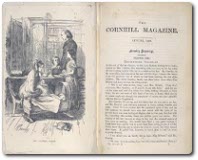Tess of the d'Urbervilles Contents
Pace
The effects of serialisation
 The pace of Victorian novels is usually fairly leisurely. Many of them were first published as serials in weekly, fortnightly or monthly magazines. This meant a story might not be resolved for up to two years. A writer, therefore, could not afford to disclose his or her main plot and characters too soon, and often created sub-plots to keep up the reader's interest. In many of Dickens' novels, the central 'mystery' does not develop until half way through the novel, at which point events often gain momentum.
The pace of Victorian novels is usually fairly leisurely. Many of them were first published as serials in weekly, fortnightly or monthly magazines. This meant a story might not be resolved for up to two years. A writer, therefore, could not afford to disclose his or her main plot and characters too soon, and often created sub-plots to keep up the reader's interest. In many of Dickens' novels, the central 'mystery' does not develop until half way through the novel, at which point events often gain momentum.
Hardy's single narrative
By contrast, Hardy is quite direct in his plotting and economical with regard to details. Unusually, he has no sub-plot to maintain momentum when less is occurring within the main plot, but relies totally on one storyline to maintain the reader's attention. In this regard, he falls back on the old picaresque structure of the first English novels, such as Defoe's Moll Flanders; the adventures of a single woman through her rise and fall. However, unlike the picaresque novel, he sticks to very few central characters and makes sure the focus is on one narrative frame.
The pace of Tess
The pace of any novel is determined by the frequency of adventures and the rate at which they are lived through. Tess's adventures are few but life-changing, rather than many and superficial. So, in fact, they are dwelt on for some time. The first phase, for example, is the longest in the novel, covering the first eleven chapters. What Hardy aims for is not surprise, a sudden rush of events, with many little climaxes, but a long anticipated build up to the single event. The pace is, literally, walking pace:
- Descriptions of landscapes or people and events happen as fast as the ground can be covered on foot
- It is the journeys that determine the novel's pace, the distance between places and events, which may be considerable when walking
- Alec and Angel speed things up by travelling quickly by coach, carriage or even train
- The sequence of events also quickens when the modern takes over (see Modernity)
- The pace of the last phase of Tess is very much quicker than any of the others. Tess and Angel seem to be reunited and then caught in very little time, as Angel's perspective takes over from Tess's.
The slowest pace is that at Talbothays. The leisurely, hot summer days are well caught by Hardy in plot, description and pace. There is the long-awaited and slow development of Tess and Angel's relationship to their wedding night, and although slightly anti-climactic, it shows Hardy's use of pace in the novel, and it has been finely judged.